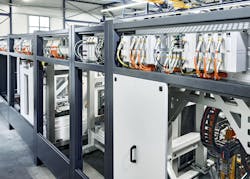Beckhoff's TwinCAT CoAgent and MX-System Tackle Industry Workforce Challenges
Automation World caught up with Beckhoff at Automate 2025 to get updates on the company’s newly renamed TwinCAT CoAgent generative AI code generation software and its MX-System.
Beckhoff describes its TwinCAT CoAgent as an intelligent AI assistant that supports PLC code development, I/O configuration and human-machine interface creation. Using natural language prompts, the TwinCAT CoAgent suggests suitable code and configurations, taking existing project structures into account.
In a recent column for Automation World, Dan Malyszko with system integrator Malisko Engineering, noted that a major benefit to using AI assistants in manufacturing is their ability to address key skills gap issues companies face as greater numbers of experienced engineers retire.
“For years, manufacturers have grappled with the fear of losing critical operational knowledge as experienced personnel retire, Malisko said. “The concern was always real but often felt intangible. Now, however, with the rapid adoption of AI, we’re at a true inflection point. The tools to preserve, structure and scale tribal knowledge finally exist.”
The tools he refers to are large language models (LLMs), which he describes as being “incredible tools for interpreting natural language prompts” — a key aspect of Beckhoff’s TwinCAT CoAgent.
TwinCAT CoAgent was originally called TwinCAT Chat when it was first introduced. Casey Taylor, U.S. software product manager at Beckhoff, explained that the name was changed to better reflect what’s happening in industry around the use of agentic AI to enable the creation of PLC agents, I/O agents and HMI agents which can be coordinated based on input prompts from the user.
For example, a user can “ask it to generate a function block and CoAgent will leverage different LLM models — such as OpenAI models, Anthropic models or even local models —and then provide a response,” said Taylor. This response can include not only the function block code for which it was prompted, but also descriptions of what’s occurring with inputs and outputs and even code examples of how the code could be implemented.
Beckhoff’s MX-System modular approach
Along with CoAgent’s ability to help address the continuing workforce shortage across industry, Beckhoff also noted how its MX-System addresses this issue with its ability to future-proof automation systems via its cabinet-free approach.
As Beckhoff explains it, the MX-System is an IP67-rated modular automation system that can be used to replace traditional control cabinets with pluggable function modules that can be mounted directly on machines for many industrial applications. This direct machine-mounting capability is enabled by the MX-System’s aluminum baseplate with integrated module slots, EtherCAT for communication and integrated distribution for different voltages. MX-System function modules include the mains connection, drives, power supplies, industrial PCs and I/O modules.
A key benefit of the MX-System is that it can be set up in one hour versus the minimum of 24 hours required to build a comparable control cabinet. “This is how the MX-System directly counters the shortage of skilled workers, as individual employees are less tied to laborious installation tasks and can move on to the next project in no time,” said Beckhoff. “A further advantage is the straightforward plug-in of the function modules, which means they do not need to be connected by specialized electricians.”
Brandon Snell, MX-System product manager at Beckhoff, explain the industry trends leading to Beckhoff’s development of the MX-System in the video below.
Also, check out this video explaining the MX-System as well as showing its quick assembly.
More Beckhoff coverage from Automation World:
About the Author
David Greenfield, editor in chief
Editor in Chief

Leaders relevant to this article:
